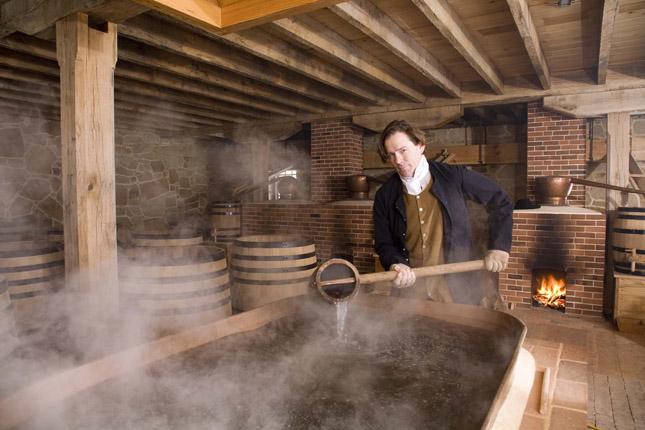Raise a Cup for President Washington’s Whiskey Punch
By • June 29, 2012 0 2353

Many presidents have gone on to have successful careers after leaving office. Jimmy Carter formed Habitat for Humanity and went on to become a global human rights campaigner and a recipient of the Nobel Peace Prize. William Howard Taft served as Chief Justice of the United States. And Bill Clinton, in addition to his charitable works, spearheaded his wife’s presidential bid in 2008
This tradition dates back to our very first president, George Washington, who became a successful whiskey-maker after his presidency. According to Dennis Pogue, vice president for preservation at George Washington’s Mount Vernon Estate, our founding father operated one of the largest whiskey distilleries in 18th-century America.
Pogue, the author of “Founding Spirits,” a detailed portrayal of the origins of the American whiskey industry, including Washington’s role, was the featured speaker during a recent event hosted by the Museum of the American Cocktail. While Pogue described the intimate details of Washington’s whiskey-making business, guests were treated to a number of classic whiskey cocktails.
Washington began distilling spirits as a way to generate income in his retirement. After leaving office, Washington moved back to Mount Vernon where he hired James Anderson, a Scotsman, as plantation manager. Anderson suggested making whiskey from the grain grown in the plantation for profit. Washington was skeptical at first, but after writing to John Fitzgerald, a trusted friend who operated a rum distillery, he decided to give it a go. Whiskey making began in early 1797 and by October of that year, Washington was confident enough to expand the operation.
Washington’s whiskey, a raw un-aged spirit, sold for 60 cents per gallon. By 1799, Washington’s distillery was the single most profitable part of his plantation. It was sold mostly to his neighbors, while some of it was bartered for items such as candles, oysters and shoe leather.
At this time in history, alcohol consumption was quite common. Washington himself drank, and he and Martha served punch to guests on various occasions. Washington had what Pogue calls a very modern view of alcohol. Washington knew drinking was a part of life but also knew there were drawbacks. He was forced to fire number of important employees because they could not control their drinking. He had officers during the war that got in trouble for abusing alcohol.
The distillery continued to operate after Washington’s death but burned to ground in 1814 and never reopened.
What did Washington’s whiskey taste like? According to Pogue the spirit was made primarily from rye, which was the typical type of whiskey produced the time. Washington’s recipe called for 60 percent rye, 35 percent corn and 5 percent malted barley. It was not aged, like whiskeys are today, although Washington did drink Madeira wine and was aware of the effect aging had on improving the taste alcohol. But whiskey that time was consumed with a primary purpose of getting drunk, and aging the spirit would require a greater investment and delay of revenue.
During the event the audience was presented with a glass of “American Whiskey Punch,” a recipe developed by cocktail historian David Wondrich, who is also a contributing scholar and member of the board of advisors of the Museum of the American Cocktail. The recipe, which highlights the spicy flavor of rye whiskey, follows a longstanding formula for punch which has been cemented in the rhyme, “One of Sour, Two of Sweet, Three of Strong, Four of Weak.”
While sipping on this classic concoction, I conjured up images of George and Martha Washington entertaining guests with their hand-made spirits at Mount Vernon. According to Derek Brown, of The Passenger and Columbia Room, punch was a popular libation during the 18th century.
Washington’s distillery and gristmill have been reconstructed and are open seasonally. The fully functioning sites are located just three miles from the Mount Vernon mansion. And in limited production, bottles of whiskey produced at the distillery are available for purchase from time to time.
Visitors may learn more about Washington’s whiskey production and purchase Dennis Pogue’s book at www.mountvernon.org For more information on informational cocktail seminars, visit MuseumOfTheAmericanCocktail.org
David Wondrich’s American Whiskey Punch
——
Muddle one cup sugar with the peel of two lemons.
Add 4 oz. lemon juice and 8 oz. water until sugar is dissolved.
Add 16 oz. Wild Turkey Rye and 3 cups water.
Serve over large block of ice in punch bowl.
Garnish with lemon wheels.

